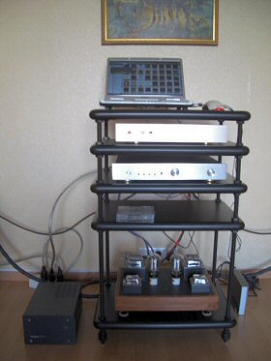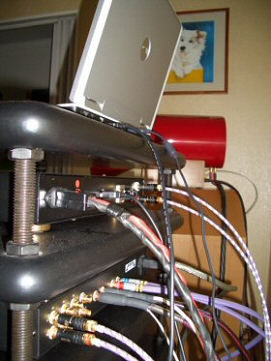Dmitry Markov, Rissia
To Bert. To all forum members who helped me along the way. To my former employer which, coincidentally, often sent me to Holland and paid me enough to satisfy my musical and aesthetic urge. To yet another former employer who provided me with free Internet and an opportunity to research the subject thoroughly. To my former girlfriend who inspired the sense of beauty in me and did not particularly object to my new strange hobby. To a Moscow carpenter Boris. To surprised small car repair shop workers who suggested Ferrari Red for the Oris 200 horns and lovingly called them “bells”. To ignorant Audi service center employees who illegally used the facilities and mismatched the colors but deservedly praised themselves for the quality of the finish. To Bert who himself modified the already finished amplifier cabinets while I was sleeping in an old time blue hair stuffed hotel in Nunspeet. To Schiphol airport security staff who despite methodically ‘losing my luggage so that they can thoroughly examine those strange components, nevertheless always sent it out a day later. And to Bert again whose friendliness and helpfulness I can not overestimate.

By sharing my story of a novice in the audio world I hope to be of help to those on a similar path. I also owe to Bert, the forum members, and all others who helped me by sharing their knowledge and experiences.
Here’s one of many similar stories. Banal and unique.
The hi-fi bug bit me several years ago when I was upgrading my school years system or, rather, its amplifier to a something cleaner sounding and more powerful so that I could
a) listen to classical music where “cleanliness” of the amp makes the entire difference between impossible and enjoyable to listen to and
b) listen at louder levels
I ended up with a mid budget transistor British amp called Aura of the B&W fame and then it all started. I had to upgrade my CD player, loudspeakers, cables… In the meantime, I had that buyer’s syndrome that many of us are so familiar with – did I make the Right choice. I kept reading. I started to buy audio magazines and spend hours in the Internet.
I was not satisfied with my veiled sounding loudspeakers but decided not to buy anything else until I find something I will not want to upgrade from. I gradually realized that there were different schools of thought in the audio world as opposed to one universal RIGHT way. Tubes and horns and the logic behind them appealed to me. Simplicity, short signals, emotional involvement that they gave to vocals, retro feel and this whole experience of watching tubes glow in the darkness – the closest thing to staring at a fire. Oh, I love that.
It took me a year of research, a visit to and comparison between the two final contenders – the Oris Horn in Nunspeet and Maestro Horn in Moscow. Maestro Horn was a rear horn extremely complicated in its high precision production. It was based on modified Lowthers, and my guess is that this was the best Lowther based rear horn in the world. I say was as the venture was later sold out to a hi-fi company which is more interested in selling 100-dollar DVD players. The speakers were grand by all means but I quickly learned I did not like Lowthers. Their “shout” made me uncomfortably tense. It was hard to realize it while listening to Maestro Horns with all their magic but it became very obvious when we switched to simpler and cheaper speakers during the audition. And when you put a weak faulty motor in a Ferrari, then what’s left of that Ferrari?
AER’s in Bert’s system were intuitively a better choice. Very detailed but compared to Lowthers also relaxing, comforting. Any speaker would sound better with them. This is how I ended up with a pair of AER’s, the best ones. Yet it took another year of anticipation of the MTM system or what came to be known as Oris Ultra.
And then several visits to Bert to see him, his dog, enjoy his hospitality and friendliness, and pick up the components. Painting, carpenting…


The system today:
Samsung 200gb 7200 rm external HDD, AC powered, connected via USB cable to Dell Inspiron 6000 notebook, best when running on batteries, connected via USB to TwinDAC+ running on batteries and feeding a Custom made active pre-amp. Built by local Moscow professionals. It is based on nuvistors, has built-in tunable filter, volume control, source switch and ! a remote control. This pre-amp is feeding 3 amps Border Patrol 300B that feeds AER MD3’s and Modified Bert’s mono-block plate amps that feed BD15’s Oris Ultra with AER MD3 and BD15 loudspeakers
Interconnect cables:
DAC-preamp: shielded copper XLO Signature 2
Preamp-amp: shielded silver Octave Electronics (Malaysia)
Preamp-bass amps: shielded silver Octave Electronics (Malaysia)
Speaker cables:
Amp-AER’s: shielded copper Coincident Speaker Technology TRS
Bass amps-BD15s: not worth mentioning, needs to be solved yet
USB cable: shielded unbranded
Power cables: entry level Kemp Elektroniks cords
Rack: Michael Green Design Justarack
Other equipment I experimented with in my system:
Amps: Aura Evolution 100 MK2, Sun Audio SV EL34SE
Pre-amps: passive attenuator based Rothwell Indus, passive transformer based Django
CD: Aura Evolution Cables: Kimber Hero, 4TC, custom made silver, Kemp digital cable
If you ask me why I messed up with Bert’s filter and plate amps, I wouldn’t know what to say. I would also not be able to tell whether it sounds better or worse. It sounds good, though. Very good. But so did the system before, with the passive Rothwell attenuator based preamp.
Future improvements:
Improve electric power cleanliness. I can now hear the effect of my other electric appliances on the sound + I hear clippings when I turn amps and DAC on and off. Play with the cabling. I picked up some high grade and thin:) silver wire at Octave Electronics with which I want to replace cabling to the BD15’s and experiment with substitution of the Coincident cables. I also want to replace the USB cable between the notebook and the DAC. I am still wondering weather fanless AC powered Via Epia motherboard based computer is better than a battery powered notebook with a constantly running fan. And then there is an AC powered external hard disk….hm-m-m. Compromises, compromises.
I was a novice, new to high-end, DIY, and how all things audio work. I would not be able to build an amp. Yet, intuitively and with guidance from Bert, his forum, and my ears I built what I think is one of the best systems money can buy. It is still not optimized but it is wonderful enough. Improvements now would be marginal. It is time to listen to music and forget about the hi-fi bug.
The hi-fi bug. Although I changed 3 amps and 3 pre-amps on the way, did that questionable modification, buried my apartment under audio magazines, and spent silly money on cables, I could have spent more cash and could have been frustrated much more with marginal improvements far from dreamed up expectations. I am glad that I first chose the direction that was emotionally and logically appealing to me. I am also glad I resisted as much as I could buying equipment with the view of future upgrade but instead opted for the “top products at reasonable prices.” In other words I went for excellent quality which, if one wanted to exceed, he would have to spend 2-10 times the money and still only get marginal improvements. It is like wearing a good cashmere sweater, a big step from the rough comfort of wool. There could be softer and lighter woolens than cashmere but how much softer and lighter. Enough for the logic.
Emotions rule here.